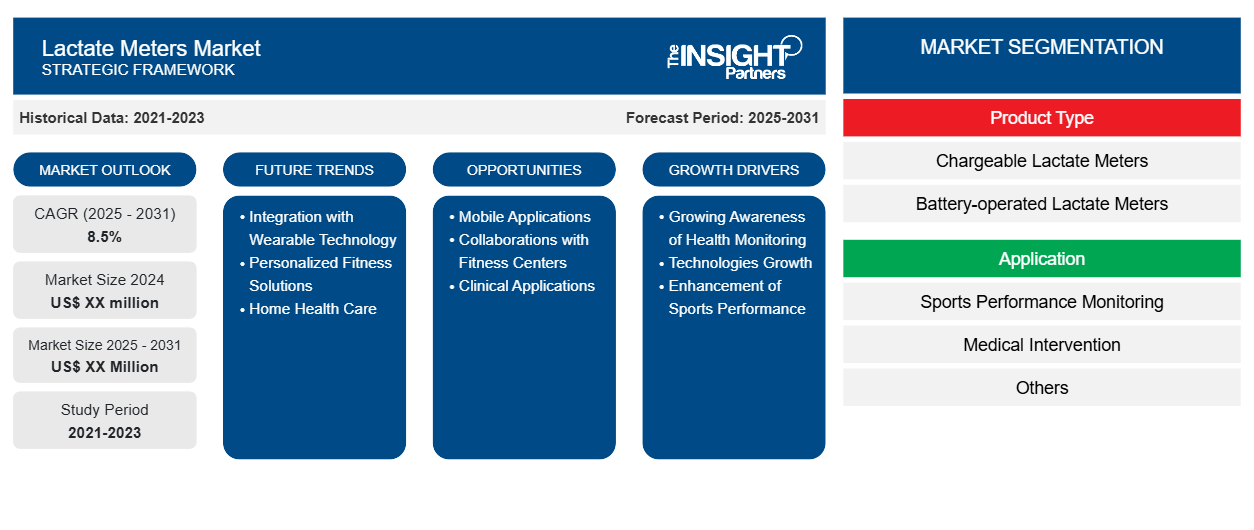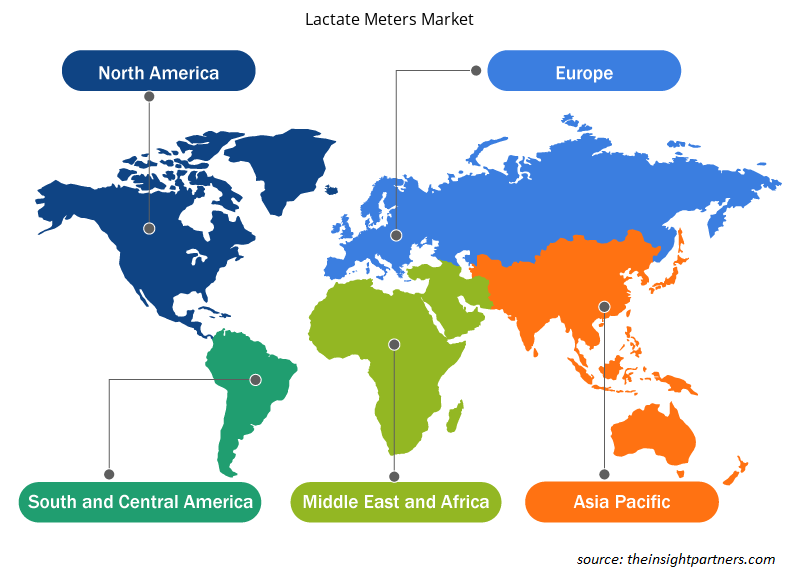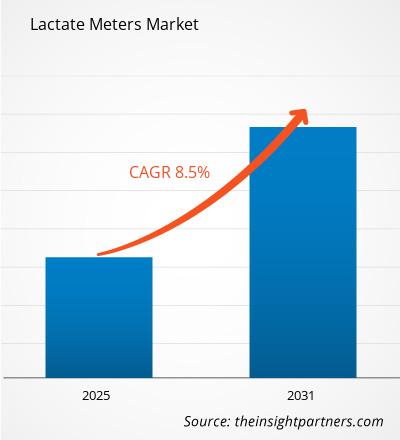The Lactate Meters Market is expected to register a CAGR of 8.5% from 2025 to 2031, with a market size expanding from US$ XX million in 2024 to US$ XX Million by 2031.
The report is segmented by Product Type (Chargeable Lactate Meters, Battery-operated Lactate Meters). The report is further segmented based on Application (Sports Performance Monitoring, Medical Intervention, Others). Futher, it is segmented based on End User (Hospitals, Clinics, Home Care, Long-term Care Services, Others). The global analysis is further broken-down at regional level and major countries. The report offers the value in USD for the above analysis and segments.
Purpose of the Report
The report Lactate Meters Market by The Insight Partners aims to describe the present landscape and future growth, top driving factors, challenges, and opportunities. This will provide insights to various business stakeholders, such as:
- Technology Providers/Manufacturers: To understand the evolving market dynamics and know the potential growth opportunities, enabling them to make informed strategic decisions.
- Investors: To conduct a comprehensive trend analysis regarding the market growth rate, market financial projections, and opportunities that exist across the value chain.
- Regulatory bodies: To regulate policies and police activities in the market with the aim of minimizing abuse, preserving investor trust and confidence, and upholding the integrity and stability of the market.
Lactate Meters Market Segmentation
Product Type
- Chargeable Lactate Meters
- Battery-operated Lactate Meters
Application
- Sports Performance Monitoring
- Medical Intervention
- Others
End User
- Hospitals
- Clinics
- Home Care
- Long-term Care Services
- Others
Geography
- North America
- Europe
- Asia-Pacific
- South and Central America
- Middle East and Africa
You will get customization on any report - free of charge - including parts of this report, or country-level analysis, Excel Data pack, as well as avail great offers and discounts for start-ups & universities
Lactate Meters Market: Strategic Insights

- Get Top Key Market Trends of this report.This FREE sample will include data analysis, ranging from market trends to estimates and forecasts.
Lactate Meters Market Growth Drivers
- Growing Awareness of Health Monitoring: In response to the growing awareness of health monitoring, more individuals and trainers are adding lactate testing to their workouts as a measure of fitness and health consciousness. This trend subsequently increases the demand for accurate and portable lactate measurement devices.
- Technologies Growth: Advancements in sensor technology and mobile connectivity improve the performance and use of lactate meters, so that they are more accessible and appealing to professional athletes and casual users.
- Enhancement of Sports Performance: Increased global sports and fitness activity coupled with high demand for measuring performance and optimizing training through accurate lactate threshold measurements is a driving factor in the market.
Lactate Meters Market Future Trends
- Integration with Wearable Technology: The lactate meters are also increasingly becoming wearable with a device that enables tracking of data very smoothly and real-time analysis of the performances for better user experience towards healthier lifestyles.
- Personalized Fitness Solutions: The growing interest in personalized fitness and training programs has driven the demand for lactate meters as each athlete seeks professional insights into their performance and recovery, enabling them to train better.
- Home Health Care: The trend towards home health care is expanding the lactate meter market due to the increasing demand for an individual to monitor their health remotely, thus increasing the demand for home testing devices friendly and efficient.
Lactate Meters Market Opportunities
- Mobile Applications: The developing companion mobile applications of the lactate meter are increasingly mushrooming to further enable users to analyse information, track progress, and share results for a more engaging experience.
- Collaborations with Fitness Centers: Partnerships with gyms and fitness centers will create visibility and acceptance of the brand as companies can sell their products as part of training programs and workshops for customers.
- Clinical Applications: First, focusing on clinical applications increases new markets within which the producer of the lactate meter reaches healthcare providers as well as patients to address the myriad conditions being managed.
Lactate Meters Market Regional Insights
The regional trends and factors influencing the Lactate Meters Market throughout the forecast period have been thoroughly explained by the analysts at Insight Partners. This section also discusses Lactate Meters Market segments and geography across North America, Europe, Asia Pacific, Middle East and Africa, and South and Central America.

- Get the Regional Specific Data for Lactate Meters Market
Lactate Meters Market Report Scope
| Report Attribute | Details |
|---|---|
| Market size in 2024 | US$ XX million |
| Market Size by 2031 | US$ XX Million |
| Global CAGR (2025 - 2031) | 8.5% |
| Historical Data | 2021-2023 |
| Forecast period | 2025-2031 |
| Segments Covered |
By Product Type
|
| Regions and Countries Covered | North America
|
| Market leaders and key company profiles |
Lactate Meters Market Players Density: Understanding Its Impact on Business Dynamics
The Lactate Meters Market is growing rapidly, driven by increasing end-user demand due to factors such as evolving consumer preferences, technological advancements, and greater awareness of the product's benefits. As demand rises, businesses are expanding their offerings, innovating to meet consumer needs, and capitalizing on emerging trends, which further fuels market growth.
Market players density refers to the distribution of firms or companies operating within a particular market or industry. It indicates how many competitors (market players) are present in a given market space relative to its size or total market value.
Major Companies operating in the Lactate Meters Market are:
- F. HOFFMANN-LA ROCHE LTD
- APEXBIO
- EKF DIAGNOSTICS
- NOVA BIOMEDICAL
- SENSA CORE MEDICAL INSTRUMENTATION PVT. LTD.
Disclaimer: The companies listed above are not ranked in any particular order.

- Get the Lactate Meters Market top key players overview
Key Selling Points
- Comprehensive Coverage: The report comprehensively covers the analysis of products, services, types, and end users of the Lactate Meters Market, providing a holistic landscape.
- Expert Analysis: The report is compiled based on the in-depth understanding of industry experts and analysts.
- Up-to-date Information: The report assures business relevance due to its coverage of recent information and data trends.
- Customization Options: This report can be customized to cater to specific client requirements and suit the business strategies aptly.
The research report on the Lactate Meters Market can, therefore, help spearhead the trail of decoding and understanding the industry scenario and growth prospects. Although there can be a few valid concerns, the overall benefits of this report tend to outweigh the disadvantages.
Frequently Asked Questions
Which are some of the major players operating in the market?
F. Hoffmann-La Roche Ltd and EKF Diagnostics are some of the major players operating in the market.
What factors are driving the lactate meters market growth?
The major factors driving the lactate meters market are:
1. Growing Awareness of Health Monitoring.
2. Enhancement of Sports Performance.
Which region dominated the lactate meters market in 2023?
North America region dominated the lactate meters market in 2023.
Which region accounted for the higesht CAGR in the lactate meters market in 2023?
Asia Pacific region accounted for the highest CAGR in the lactate meters market.
What are the key benefits of the lactate meters market report?
The report provides an extensive qualitative and quantitative analysis of the current trends and future estimations of the global lactate meters market from 2021 to 2031, and it also determines the prevailing opportunities.
What is the expected CAGR of the Lactate Meters Market?
The Lactate Meters Market is estimated to witness a CAGR of 8.5% from 2023 to 2031
- Historical Analysis (2 Years), Base Year, Forecast (7 Years) with CAGR
- PEST and SWOT Analysis
- Market Size Value / Volume - Global, Regional, Country
- Industry and Competitive Landscape
- Excel Dataset
Testimonials
I wish to appreciate your support and the professionalism you displayed in the course of attending to my request for information regarding to infectious disease IVD market in Nigeria. I appreciate your patience, your guidance, and the fact that you were willing to offer a discount, which eventually made it possible for us to close a deal. I look forward to engaging The Insight Partners in the future, all thanks to the impression you have created in me as a result of this first encounter.
DR CHIJIOKE ONYIA, MANAGING DIRECTOR, PineCrest Healthcare Ltd.The Insight Partners delivered insightful, well-structured market research with strong domain expertise. Their team was professional and responsive throughout. The user-friendly website made accessing industry reports seamless. We highly recommend them for reliable, high-quality research services
Yukihiko Adachi CEO, Deep Blue, LLC.Reason to Buy
- Informed Decision-Making
- Understanding Market Dynamics
- Competitive Analysis
- Customer Insights
- Market Forecasts
- Risk Mitigation
- Strategic Planning
- Investment Justification
- Identifying Emerging Markets
- Enhancing Marketing Strategies
- Boosting Operational Efficiency
- Tracking Industry Innovations
- Aligning with Regulatory Trends
Yes! We provide a free sample of the report, which includes Report Scope (Table of Contents), report structure, and selected insights to help you assess the value of the full report. Please click on the "Download Sample" button or contact us to receive your copy.
Absolutely — analyst assistance is part of the package. You can connect with our analyst post-purchase to clarify report insights, methodology or discuss how the findings apply to your business needs.
Once your order is successfully placed, you will receive a confirmation email along with your invoice.
• For published reports: You’ll receive access to the report within 4–6 working hours via a secured email sent to your email.
• For upcoming reports: Your order will be recorded as a pre-booking. Our team will share the estimated release date and keep you informed of any updates. As soon as the report is published, it will be delivered to your registered email.
We offer customization options to align the report with your specific objectives. Whether you need deeper insights into a particular region, industry segment, competitor analysis, or data cut, our research team can tailor the report accordingly. Please share your requirements with us, and we’ll be happy to provide a customized proposal or scope.
The report is available in either PDF format or as an Excel dataset, depending on the license you choose.
The PDF version provides the full analysis and visuals in a ready-to-read format. The Excel dataset includes all underlying data tables for easy manipulation and further analysis.
Please review the license options at checkout or contact us to confirm which formats are included with your purchase.
Our payment process is fully secure and PCI-DSS compliant.
We use trusted and encrypted payment gateways to ensure that all transactions are protected with industry-standard SSL encryption. Your payment details are never stored on our servers and are handled securely by certified third-party processors.
You can make your purchase with confidence, knowing your personal and financial information is safe with us.
Yes, we do offer special pricing for bulk purchases.
If you're interested in purchasing multiple reports, we’re happy to provide a customized bundle offer or volume-based discount tailored to your needs. Please contact our sales team with the list of reports you’re considering, and we’ll share a personalized quote.
Yes, absolutely.
Our team is available to help you make an informed decision. Whether you have questions about the report’s scope, methodology, customization options, or which license suits you best, we’re here to assist. Please reach out to us at sales@theinsightpartners.com, and one of our representatives will get in touch promptly.
Yes, a billing invoice will be automatically generated and sent to your registered email upon successful completion of your purchase.
If you need the invoice in a specific format or require additional details (such as company name, GST, or VAT information), feel free to contact us, and we’ll be happy to assist.
Yes, certainly.
If you encounter any difficulties accessing or receiving your report, our support team is ready to assist you. Simply reach out to us via email or live chat with your order information, and we’ll ensure the issue is resolved quickly so you can access your report without interruption.















The List of Companies
1. F. HOFFMANN-LA ROCHE LTD
2. APEXBIO
3. EKF DIAGNOSTICS
4. NOVA BIOMEDICAL
5. SENSA CORE MEDICAL INSTRUMENTATION PVT. LTD.
6. ARKRAY, INC.
7. BST BIO SENSOR TECHNOLOGY
8. TAIDOC TECHNOLOGY
9. WOODLEY EQUIPMENT






 Get Free Sample For
Get Free Sample For